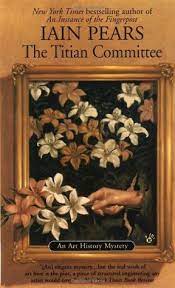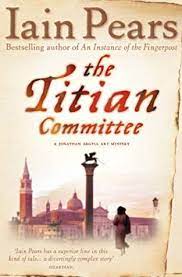GoodReads meta-data is 230 pages rated 3.62 by 1,690 litizens
Genre: krimi
Verdict: An Old Master.

A committee of scholars – art historians – is charged with preparing the definitive catalogue raisonné of the works of Tiziano Vecellio (1488-1576), that is Titian to you and TV to me from now on. Since he did not report to a Scholarly Output Index managed by McKinsey acolytes, TV did not keepT 4 track of his works, nor sign all of them to get credit on his CV for his next application to use the toilet. He just took the money.
Naive readers might think the members of this committee would examine the paintings, drawings, frescoes, sketches, notebook that might be by TV, magnifying glass in hand and even subject them to scientific tests and such. Ah! Such methods are always intrusive and sometimes destructive. Moreover, the owners of the works may not wish to have the painting, say, shipped to a laboratory elsewhere for such a six-month examination. Such a process is not only slow, it is expensive and not conclusive every time. Owners may also prefer to believe the work genuine and not risk the analysis to produce a negative result. Instead this panel of experts foregathers annually in Venice to evaluate another group of Titian works based on the library research they have done back home supplemented by the archives in Venice. This has been going on for years with very little to show for the collective effort (and expense), though each scholar has broadcast membership on the committee on the CV.

The members include an American, a Brit, a German, another American, a third American, a Hollander, and, oh, a token Italian or two. Like any good panel of experts this one is riven by dissension, envy, insecurity, sexual blackmail, rivalries, and its members are professionally committed to disagreeing about almost everything. The one thing lacking is a Post-Modernist who would dispute the existence of the man called Titian and/or declare that all the masterpieces attributed to him were done by his wife, Cecilia, although the fact that she had died by the time most of the work was done would only slow not stop the attribution.
Yet the pressure is now on from the funding agency to get some results. Back in Rome someone has noticed this drain on finance. The founding chairman resigned in frustration, having been skilfully undermined by his replacement who then launches a charm offensive with many expensive dinners, amid the bickering and backbiting, to wear down if not win over the recalcitrant colleagues – to no avail. The harder he tries the more obstructive they become, biting ever harder the feeding hand. Then, well, one of them is murdered, and briefly the other members are subdued albeit only briefly. Indeed, most soon regard the murder of one of their number as just the kind of publicity stunt the victim would pull to distract them! In no time they are back at each others’ metaphorical throats, until that becomes literal and another one is murdered!
To this reader the explanation was obvious. The chair of the committee was killing off the members of the committee to get a consensus from the survivors. It was also obvious that it would never work, of course, no academic has enough imagination to suppose they will be the next to be murdered, still less an aptitude for compromise even at the expense of survival. (I saw more than a few examples of this lack of imagination and aptitude as director of an institute, associate dean of a faculty, and head of a department. I learned that reasoning with scholars was pointless.)
But no, the plot twists away from this obvious explanation. Still, it set me thinking.
Iain Pears wrote seven of these art history mysteries featuring the hapless ex-patriate Jonathan Argyll, resident in Rome as the purchasing agent for a British antique dealer, and his on-again off-again girlfriend Flavia di Stefano who works for the national art crime squad. If Jonathan is vague, she is decisive. If he is confused, she is certain. If he dresses like the down at the heel scholar he is, she sports the latest Milano elegance. If he picks at his food, she devours all creatures great and small. He meanders, she dives straight in. And so on. They make an odd couple. Villains underestimate each of them. Him because he has the air of an absentminded professor and her because she is a woman. I wish there were more of their stories for I have read all seven, more than once.
They are backed by General Bottando who is head of the Art Squad, long time master of the intrigues of bureaucracy and proven survivor of budget cutters, turf war rivals, McKinsey re-organisers, and even the Mafia on one occasion. He has planted so many seeds of doubt about his numerous enemies and rivals in officialdom, in the media, in the world of high finance, and in that of low life, so he has but to harvest the crop occasionally to secure his department. If only I had learned from such a master tactician. He is, by the way, a general because among the seven branches of Italian police the art squad is, for reasons long lost in the mists of time, an off-shoot of the military police. ‘Something to do with looted treasures after the last war,’ he once explained to Jonathan. There is no doubt that the very large Bottando is an imposing figure. Having taken care over the years for intermediaries to recommend him for many medals, he almost jingles when he strides in full dress uniform, worn only to intimidate lesser beings. In his more paternalistic moments, when not decapitating a bureaucratic rival, he sees himself as a matchmaker between Jonathan and Flavia.

When someone recently mentioned krimi in an academic setting I thought of this amusing title.

